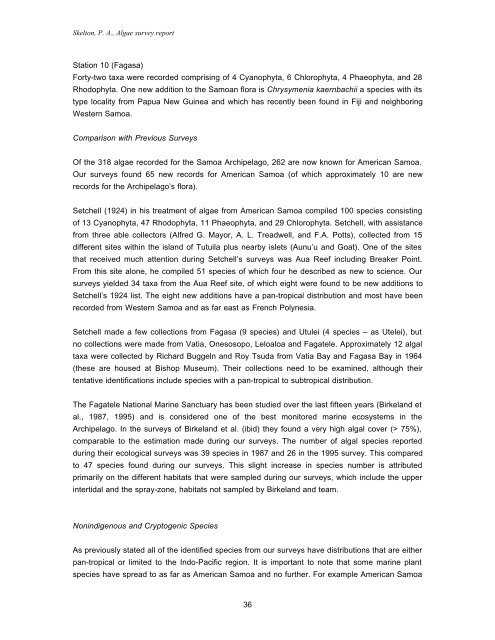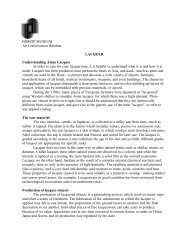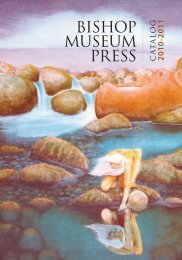INTRODUCED MARINE SPECIES IN PAGO ... - Bishop Museum
INTRODUCED MARINE SPECIES IN PAGO ... - Bishop Museum
INTRODUCED MARINE SPECIES IN PAGO ... - Bishop Museum
You also want an ePaper? Increase the reach of your titles
YUMPU automatically turns print PDFs into web optimized ePapers that Google loves.
Skelton, P. A., Algae survey report<br />
Station 10 (Fagasa)<br />
Forty-two taxa were recorded comprising of 4 Cyanophyta, 6 Chlorophyta, 4 Phaeophyta, and 28<br />
Rhodophyta. One new addition to the Samoan flora is Chrysymenia kaernbachii a species with its<br />
type locality from Papua New Guinea and which has recently been found in Fiji and neighboring<br />
Western Samoa.<br />
Comparison with Previous Surveys<br />
Of the 318 algae recorded for the Samoa Archipelago, 262 are now known for American Samoa.<br />
Our surveys found 65 new records for American Samoa (of which approximately 10 are new<br />
records for the Archipelago’s flora).<br />
Setchell (1924) in his treatment of algae from American Samoa compiled 100 species consisting<br />
of 13 Cyanophyta, 47 Rhodophyta, 11 Phaeophyta, and 29 Chlorophyta. Setchell, with assistance<br />
from three able collectors (Alfred G. Mayor, A. L. Treadwell, and F.A. Potts), collected from 15<br />
different sites within the island of Tutuila plus nearby islets (Aunu’u and Goat). One of the sites<br />
that received much attention during Setchell’s surveys was Aua Reef including Breaker Point.<br />
From this site alone, he compiled 51 species of which four he described as new to science. Our<br />
surveys yielded 34 taxa from the Aua Reef site, of which eight were found to be new additions to<br />
Setchell’s 1924 list. The eight new additions have a pan-tropical distribution and most have been<br />
recorded from Western Samoa and as far east as French Polynesia.<br />
Setchell made a few collections from Fagasa (9 species) and Utulei (4 species – as Utelei), but<br />
no collections were made from Vatia, Onesosopo, Leloaloa and Fagatele. Approximately 12 algal<br />
taxa were collected by Richard Buggeln and Roy Tsuda from Vatia Bay and Fagasa Bay in 1964<br />
(these are housed at <strong>Bishop</strong> <strong>Museum</strong>). Their collections need to be examined, although their<br />
tentative identifications include species with a pan-tropical to subtropical distribution.<br />
The Fagatele National Marine Sanctuary has been studied over the last fifteen years (Birkeland et<br />
al., 1987, 1995) and is considered one of the best monitored marine ecosystems in the<br />
Archipelago. In the surveys of Birkeland et al. (ibid) they found a very high algal cover (> 75%),<br />
comparable to the estimation made during our surveys. The number of algal species reported<br />
during their ecological surveys was 39 species in 1987 and 26 in the 1995 survey. This compared<br />
to 47 species found during our surveys. This slight increase in species number is attributed<br />
primarily on the different habitats that were sampled during our surveys, which include the upper<br />
intertidal and the spray-zone, habitats not sampled by Birkeland and team.<br />
Nonindigenous and Cryptogenic Species<br />
As previously stated all of the identified species from our surveys have distributions that are either<br />
pan-tropical or limited to the Indo-Pacific region. It is important to note that some marine plant<br />
species have spread to as far as American Samoa and no further. For example American Samoa<br />
36






